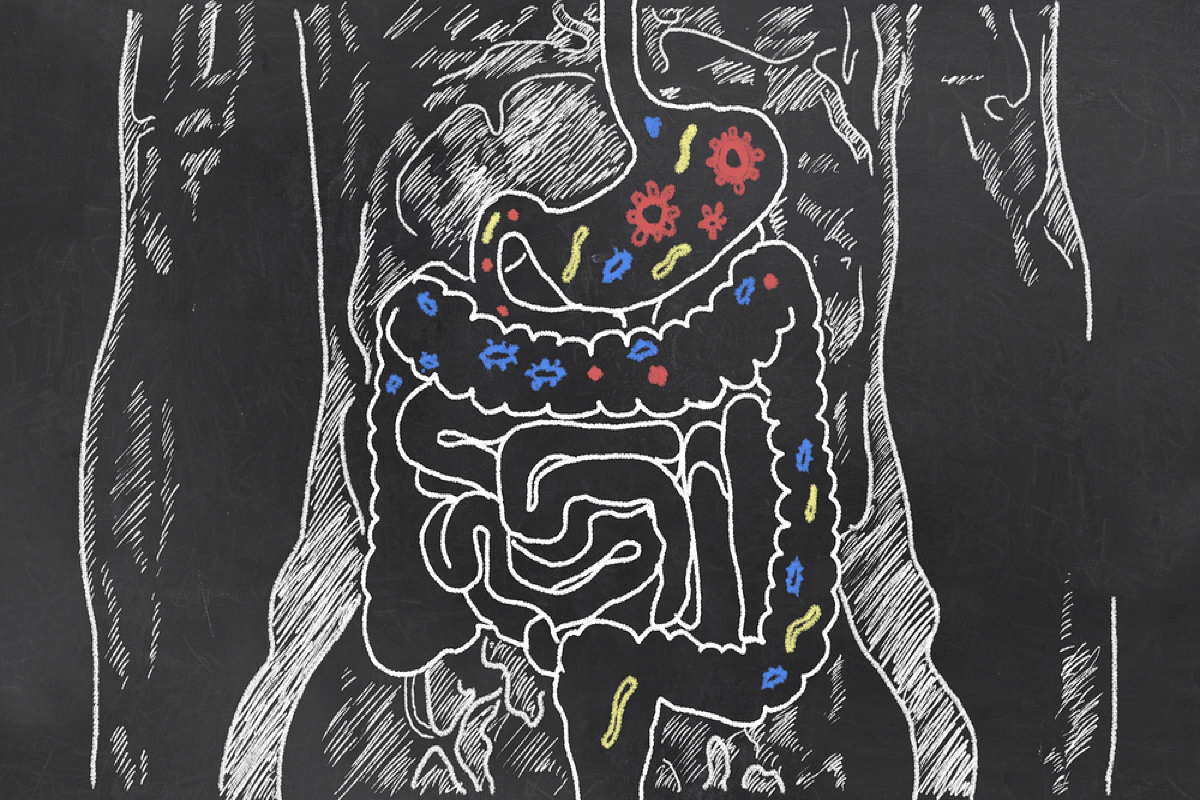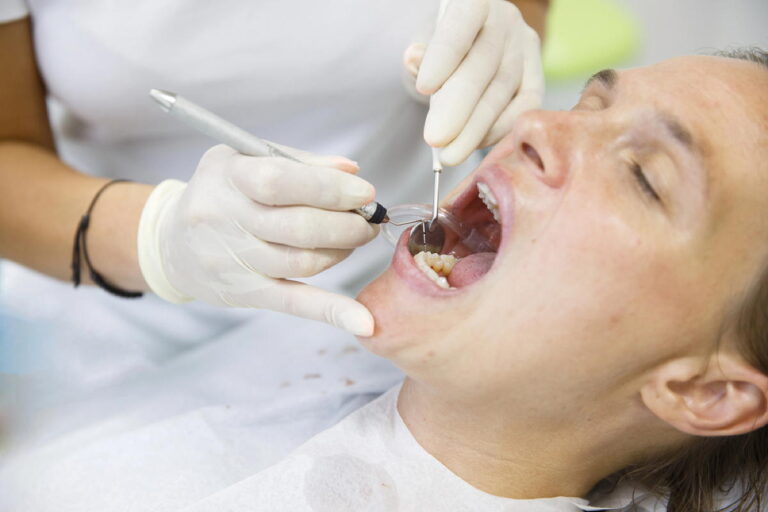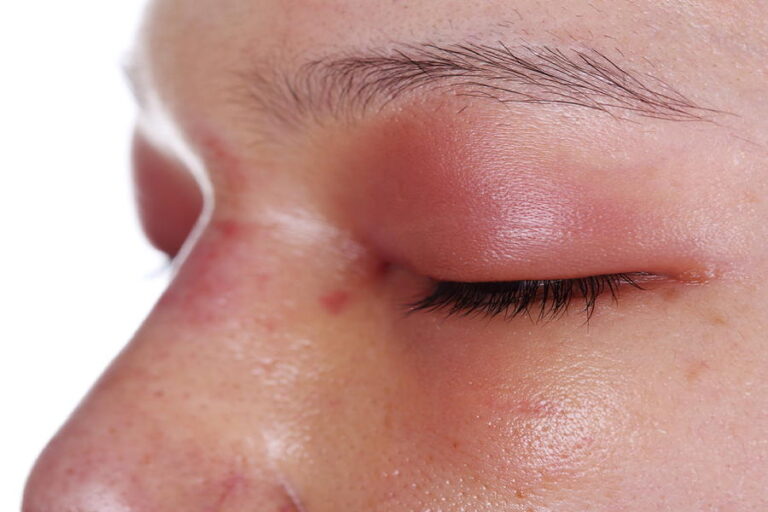Build up intestinal flora after antibiotics – here’s how
Antibiotika haben vielen bakteriellen Infektionen ihren Schrecken genommen, doch ihre zuverlässige Wirkung kann auch die erwünschten Bakterien der Darmflora in Mitleidenschaft ziehen.
Dies kann zu unangenehmen Nebenwirkungen führen. Wenn du deine Darmflora
nach einer Antibiotika-Behandlung wieder aufbaust, kannst du deine Gesundheit und dein Wohlbefinden langfristig verbessern.
In diesem Ratgeber erfährst du, wie Antibiotika deine Darmflora beeinflussen und warum ein gesundes Mikrobiom wichtig ist. Wir zeigen dir, wie du mit probiotischen und präbiotischen Lebensmitteln deine Darmbakterien unterstützen kannst.
Was passiert bei einer Antibiotika-Behandlung?
Wenn du Antibiotika einnimmst, kann dies erhebliche Auswirkungen auf deine Darmflora haben. Dein Darm beherbergt ein komplexes Ökosystem aus etwa 100 Billionen Bakterienzellen, das als Mikrobiom oder Darmflora bezeichnet wird.
Wirkungsweise von Antibiotika
Antibiotika sind Medikamente, die darauf abzielen, krankheitserregende Bakterien zu bekämpfen. Sie können jedoch nicht zwischen schädlichen und nützlichen Bakterien unterscheiden. Dies führt dazu, dass auch die nützlichen Bakterien in deinem Darm angegriffen werden.
Warum Antibiotika die Darmflora schädigen
Besonders Breitbandantibiotika können deine Darmflora stark reduzieren und das empfindliche Gleichgewicht im Darm stören. Studien zeigen, dass nach einer Antibiotika-Behandlung zunächst vermehrt potenziell schädliche Bakterien auftreten können, bevor sich die nützlichen Bakterien wieder ansiedeln. Dies kann zu einer Reihe von Verdauungsproblemen und anderen gesundheitlichen Beschwerden führen.
Wie ein Experte betont: “Die Schädigung der Darmflora durch Antibiotika ist ein ernstes Problem, das langfristige Auswirkungen auf die Gesundheit haben kann.”
Die Bedeutung einer gesunden Darmflora
Eine gesunde Darmflora ist entscheidend für dein allgemeines Wohlbefinden. Dein Darm ist nicht nur für die Verdauung zuständig, sondern spielt auch eine wichtige Rolle bei der Abwehr von Krankheitserregern und der Produktion von Vitaminen.
Das Mikrobiom und seine Funktionen
Das Mikrobiom, also die Gesamtheit aller Mikroorganismen in deinem Darm, ist ein komplexes Ökosystem. Es umfasst eine Vielzahl von Bakterien, die verschiedene Funktionen haben, wie die Unterstützung deiner Immunabwehr und die Produktion von kurzkettigen Fettsäuren, die deine Darmgesundheit fördern.
Die Darm-Hirn-Achse
Zwischen deinem Darm und deinem Gehirn besteht eine enge Verbindung, die sogenannte Darm-Hirn-Achse. “Der Darm sendet Nervenimpulse ans Gehirn – und umgekehrt,” wie Studien zeigen. Diese Kommunikation erfolgt über den Vagusnerv und biochemische Botenstoffe. Die Zusammensetzung deines Mikrobioms kann Auswirkungen auf deine Stimmung, dein Stressempfinden und sogar dein Risiko für psychische Erkrankungen haben. Stress kann zudem die Zusammensetzung deiner Darmflora negativ beeinflussen, was zu Verdauungsproblemen führen kann.
Einige wichtige Aspekte der Darm-Hirn-Achse sind:
- Die ständige Kommunikation zwischen Darm und Gehirn über den Vagusnerv und biochemische Botenstoffe.
- Die Auswirkungen der Mikrobiom-Zusammensetzung auf deine Stimmung und dein Stressempfinden.
- Der Einfluss von Stress auf die Darmflora und mögliche Verdauungsprobleme.
Anzeichen einer geschädigten Darmflora
Eine Antibiotika-Therapie kann die Balance deiner Darmflora stören. Wenn du Antibiotika eingenommen hast, kann dies zu einer Verschiebung in der Zusammensetzung deiner Darmbakterien führen.
Typische Beschwerden nach Antibiotika-Einnahme
Nach der Einnahme von Antibiotika kannst du verschiedene Beschwerden erleben, die auf eine gestörte Darmflora hinweisen. Dazu gehören unter anderem Blähungen, Durchfall und Bauchschmerzen. Eine geschwächte Darmflora kann auch das Immunsystem beeinträchtigen.
Langfristige Folgen einer gestörten Darmflora
Eine langfristig gestörte Darmflora kann zu weitreichenden Auswirkungen auf deine Gesundheit führen. Studien deuten darauf hin, dass dies das Risiko für chronisch-entzündliche Darmerkrankungen und andere Erkrankungen erhöhen kann. Ein unausgewogenes Darmmikrobiom wird auch mit Allergien, Nahrungsmittelunverträglichkeiten und einem geschwächten Immunsystem in Verbindung gebracht.
Wie lange dauert die Regeneration der Darmflora?
Die Dauer der Regeneration deiner Darmflora hängt von verschiedenen Faktoren ab, die du teilweise selbst in der Hand hast. Eine wichtige Rolle spielt hierbei deine Ernährung.
Natürlicher Regenerationsprozess
Deine Darmflora hat die Fähigkeit, sich nach einer Schädigung, beispielsweise durch die Einnahme von Antibiotika, wieder zu regenerieren. Dieser natürliche Prozess kann jedoch durch verschiedene Faktoren beeinflusst werden.
Eine ballaststoffreiche und abwechslungsreiche Ernährung fördert die Wiederansiedlung nützlicher Bakterien in deiner Darmflora.
Faktoren, die die Regenerationszeit beeinflussen
Die Art und Dauer der Antibiotika-Einnahme kann stark beeinflussen, wie sehr deine Darmflora beeinträchtigt wird und wie lange die Regeneration dauert. Zudem kann Stress den Regenerationsprozess verlangsamen, da er sich negativ auf die Zusammensetzung deiner Darmflora auswirkt.

Darmflora aufbauen nach Antibiotika – Grundprinzipien
Nach einer Antibiotika-Behandlung ist es wichtig, deine Darmflora wieder aufzubauen. Eine gesunde Darmflora ist entscheidend für deine allgemeine Gesundheit und dein Wohlbefinden.
Das Gleichgewicht der Darmbakterien wiederherstellen
Deine Darmflora besteht aus einer Vielzahl von Bakterien, die in einem empfindlichen Gleichgewicht stehen. Um dieses Gleichgewicht wiederherzustellen, solltest du auf eine ausgewogene Ernährung achten.
Die Rolle der Ernährung im Regenerationsprozess
Deine Ernährung spielt eine Schlüsselrolle beim Wiederaufbau deiner Darmflora. Eine ausgewogene Ernährung mit viel Gemüse und Vollkornprodukten kann helfen, das Mikrobiom im Gleichgewicht zu halten, wie Ernährungs-Doc Matthias Riedl betont.
- Eine ballaststoffreiche Ernährung fördert das Wachstum nützlicher Bakterien, da Ballaststoffe als Nahrung für deine Darmbakterien dienen.
- Eine abwechslungsreiche Ernährung mit vielen verschiedenen pflanzlichen Lebensmitteln unterstützt die Vielfalt deiner Darmflora.
- Verarbeitete Lebensmittel mit viel Zucker und Fett solltest du reduzieren, da sie das Wachstum potenziell schädlicher Bakterien begünstigen können.
Probiotische Lebensmittel für eine gesunde Darmflora
Probiotische Lebensmittel sind eine großartige Möglichkeit, die Darmflora nach einer Antibiotika-Behandlung wieder zu stärken. Sie enthalten lebende Mikroorganismen, die die Darmgesundheit unterstützen und das Gleichgewicht der Darmflora wiederherstellen können.
Du kannst probiotische Lebensmittel in deinen Alltag integrieren, indem du bestimmte Produkte konsumierst, die reich an diesen nützlichen Bakterien sind.
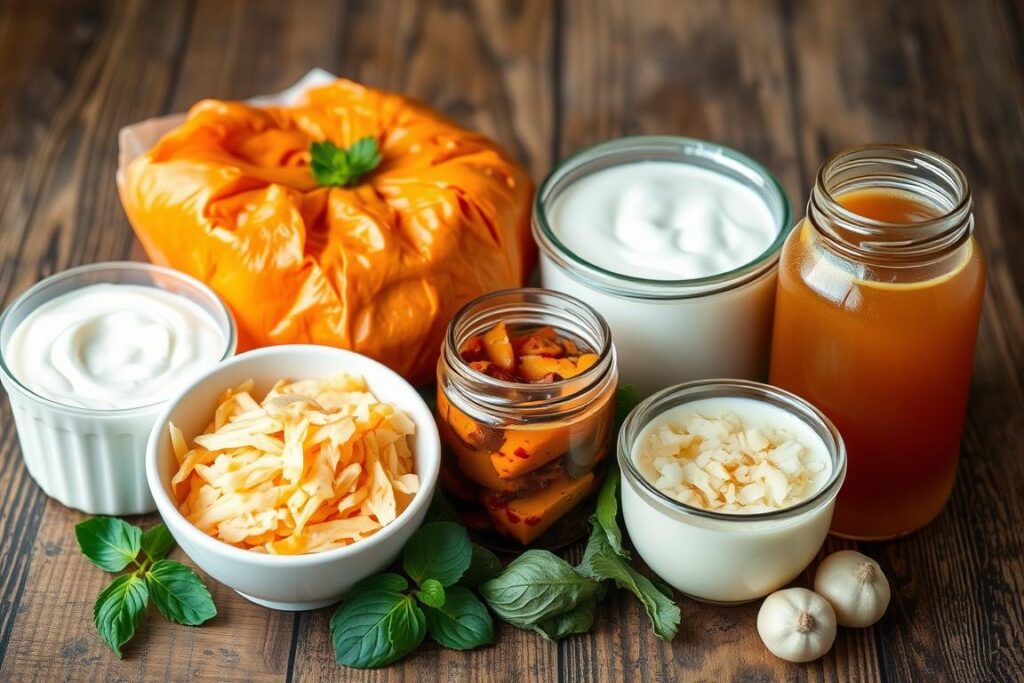
Fermentierte Milchprodukte
Fermentierte Milchprodukte sind reich an probiotischen Bakterien. Sie bieten eine einfache Möglichkeit, deine Darmflora zu unterstützen.
Joghurt und Kefir
Joghurt und Kefir sind beliebte fermentierte Milchprodukte, die probiotische Bakterien enthalten. Sie können helfen, die Darmflora zu stärken.
Buttermilch und Dickmilch
Buttermilch und Dickmilch sind weitere Beispiele für fermentierte Milchprodukte, die deine Darmflora unterstützen können.
Fermentiertes Gemüse
Fermentiertes Gemüse ist eine weitere großartige Quelle für probiotische Bakterien. Es kann leicht in deine Ernährung integriert werden.
Sauerkraut und Kimchi
Sauerkraut und Kimchi sind bekannte Beispiele für fermentiertes Gemüse, das probiotische Bakterien enthält. Sie können helfen, die Darmflora zu stärken.
Weitere fermentierte Lebensmittel
Neben Sauerkraut und Kimchi gibt es viele weitere fermentierte Lebensmittel, die deine Darmflora unterstützen können. Einige Beispiele sind eingelegte Gurken (Pickles), Miso, Kombucha, Tempeh und Natto.
Präbiotische Lebensmittel zur Unterstützung der Darmflora

Damit deine Darmbakterien gedeihen, benötigst du präbiotische Lebensmittel, die ihnen als Nahrung dienen. Präbiotika sind nicht-verdauliche Bestandteile deiner Nahrung, die das Wachstum nützlicher Darmbakterien fördern.
Ballaststoffreiche Kost
Ballaststoffreiche Lebensmittel sind eine wichtige Quelle für Präbiotika. Sie helfen, die Darmflora zu stärken und das Mikrobiom ins Gleichgewicht zu bringen.
Vollkornprodukte und Hülsenfrüchte
Vollkornprodukte und Hülsenfrüchte sind reich an Ballaststoffen und dienen als Nahrung für nützliche Bakterienstämme in deinem Darm.
Inulinhaltige Lebensmittel
Inulin ist ein Präbiotikum, das in Lebensmitteln wie Chicorée und Topinambur vorkommt. Es fördert das Wachstum von Darmbakterien, die für eine gesunde Darmflora sorgen.
Obst und Gemüse mit präbiotischer Wirkung
Bestimmte Obst- und Gemüsesorten haben eine präbiotische Wirkung und unterstützen die Gesundheit deiner Darmflora.
Chicorée, Topinambur und Artischocken
Chicorée, Topinambur und Artischocken sind reich an Inulin und anderen Präbiotika, die das Wachstum nützlicher Darmbakterien fördern.
Zwiebeln, Knoblauch und Bananen
Zwiebeln und Knoblauch enthalten Fructooligosaccharide, die als Nahrung für bestimmte Bakterienstämme dienen. Bananen, besonders wenn sie noch nicht vollreif sind, enthalten resistente Stärke, die präbiotisch wirkt.
Probiotische Präparate aus der Apotheke
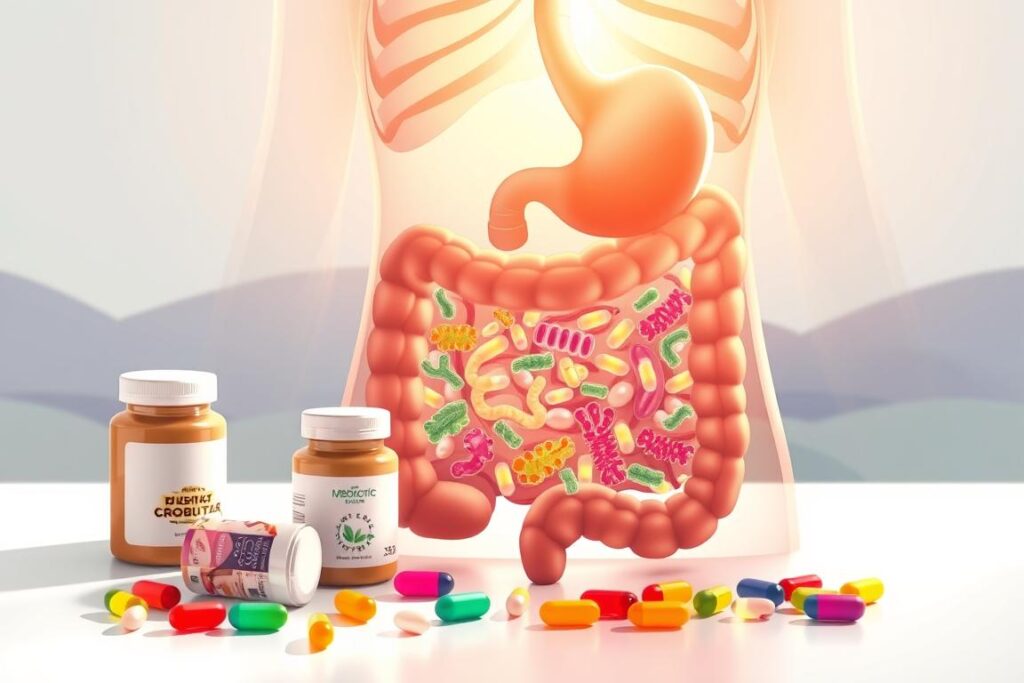
Um die Darmflora nach Antibiotika zu unterstützen, bieten sich probiotische Präparate aus der Apotheke an. Diese Präparate können helfen, die Darmflora wieder aufzubauen und das Gleichgewicht der Darmbakterien wiederherzustellen.
Verschiedene Bakterienstämme und ihre Wirkung
Es gibt verschiedene Bakterienstämme, die in probiotischen Präparaten verwendet werden. Jeder Stamm hat seine spezifische Wirkung auf die Darmflora. Einige Stämme können die Verdauung unterstützen, während andere das Immunsystem stärken.
Dosierung und Anwendungsdauer
Die richtige Dosierung und Anwendungsdauer probiotischer Präparate ist entscheidend für ihre Wirksamkeit. In der Regel sollten Probiotika täglich und über mehrere Wochen eingenommen werden. Die empfohlene Dosierung variiert je nach Präparat und Bakterienstamm, liegt aber typischerweise zwischen 1 und 10 Milliarden koloniebildenden Einheiten (KBE) pro Tag. Es ist ratsam, einen zeitlichen Abstand von mindestens 2-3 Stunden zwischen Antibiotikum und Probiotikum einzuhalten. Sprich mit deinem Arzt über die für dich optimale Dosierung und Anwendungsdauer.
Präbiotische Nahrungsergänzungsmittel
Die Einnahme von Präbiotika in Form von Nahrungsergänzungsmitteln kann helfen, das Gleichgewicht deiner Darmflora wiederherzustellen.
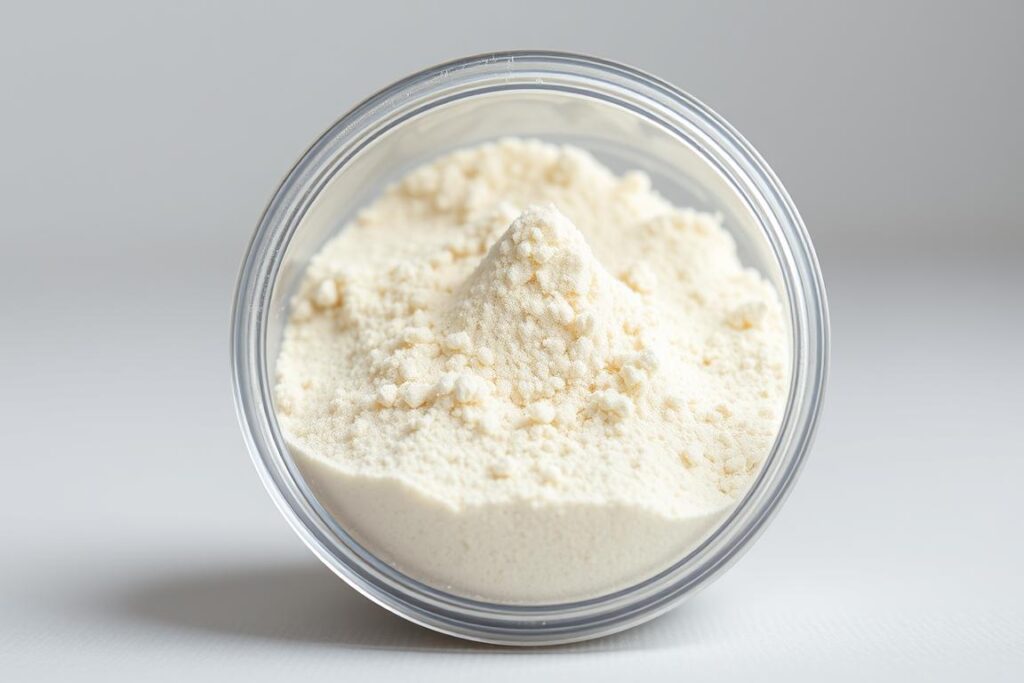
Präbiotische Nahrungsergänzungsmittel enthalten oft Inulin und Oligofruktose, welche die Darmgesundheit unterstützen.
Inulin und Oligofruktose
Inulin und Oligofruktose sind bekannte Präbiotika, die die Darmflora positiv beeinflussen. Sie dienen als Nahrung für nützliche Bakterien und fördern deren Wachstum.
Diese Substanzen sind in verschiedenen Pflanzen enthalten und können durch Nahrungsergänzungsmittel ergänzt werden.
Richtige Anwendung und Dosierung
Um optimale Ergebnisse zu erzielen, ist eine tägliche Aufnahme von etwa 5 Gramm Präbiotika empfehlenswert. Beginne mit einer niedrigen Dosierung und steigere diese langsam.
Achte auf mögliche anfängliche Nebenwirkungen wie Blähungen oder Völlegefühl.
Symbiotika – die Kombination aus Pro- und Präbiotika

Die Kombination aus Probiotika und Präbiotika, bekannt als Symbiotika, unterstützt die Regeneration deiner Darmflora. Symbiotika sind Nahrungsergänzungsmittel, die sowohl probiotische als auch präbiotische Wirkstoffe enthalten, um deine Darmflora zu stärken.
Vorteile der kombinierten Anwendung
Die Kombination von Pro- und Präbiotika in Symbiotika bietet eine synergistische Wirkung, die die Effektivität beider Komponenten erhöht. Durch die gleichzeitige Einnahme von Probiotika und Präbiotika kannst du die Ansiedlung der nützlichen Bakterien in deinem Darm fördern und ihre Aktivität steigern.
Anwendungsempfehlungen
Für die Anwendung von Symbiotika gelten ähnliche Empfehlungen wie für probiotische Präparate. Die Einnahme sollte regelmäßig und idealerweise täglich erfolgen, um nachhaltige Effekte auf deine Darmflora zu erzielen.
Ernährungsplan für den Darmaufbau
Der Wiederaufbau deiner Darmflora nach Antibiotika erfordert eine gezielte Ernährungsumstellung. Eine ausgewogene Ernährung ist entscheidend, um das Mikrobiom im Gleichgewicht zu halten.
Die ersten Tage nach der Antibiotika-Einnahme
In den ersten Tagen nach der Antibiotika-Einnahme solltest du auf eine leichte Ernährung achten. “Bei gesunden Menschen reicht in der Regel schon eine ausgewogene Ernährung mit Gemüse und Vollkornprodukten, um das Mikrobiom im Gleichgewicht zu halten”, sagt Ernährungs-Doc Matthias Riedl.
Langfristige Ernährungsumstellung
Für eine langfristig gesunde Darmflora ist eine dauerhafte Ernährungsumstellung sinnvoller als kurzfristige Maßnahmen. Baue deinen Speiseplan um eine Vielfalt an pflanzlichen Lebensmitteln auf und integriere regelmäßig fermentierte Lebensmittel wie Joghurt, Kefir, Sauerkraut oder Kimchi in deine Ernährung.
Reduziere stark verarbeitete Lebensmittel, Zucker und tierische Fette, die das Wachstum potenziell schädlicher Bakterien begünstigen können. Eine mediterrane Ernährungsweise mit viel Gemüse, Olivenöl, Fisch und Vollkornprodukten hat sich in Studien als besonders förderlich für die Darmgesundheit erwiesen.
Die Bedeutung von Essenspausen für die Darmgesundheit
Essenspausen können deine Darmgesundheit unterstützen, indem sie deinem Darm regelmäßige Ruhephasen gönnen. Eine gesunde Darmflora ist entscheidend für dein Wohlbefinden.
Dein Darm hat einen natürlichen Biorhythmus, der durch Essenspausen unterstützt werden kann. Dieser Rhythmus ist wichtig für die Regeneration und Balance deiner Darmflora.
Der Biorhythmus des Darms
Dein Darm ist nicht ständig aktiv, sondern hat Phasen der Aktivität und Ruhe. Diese natürlichen Schwankungen sind wichtig für die Gesundheit deiner Darmflora und können durch regelmäßige Essenspausen unterstützt werden.
Intervallfasten zur Unterstützung der Darmflora
Intervallfasten kann eine effektive Methode sein, um deinem Darm regelmäßige Ruhephasen zu gönnen. Beim Intervallfasten beschränkst du deine Nahrungsaufnahme auf ein bestimmtes Zeitfenster und fastest die restlichen Stunden des Tages.
- Studien zeigen, dass Intervallfasten die Vielfalt des Mikrobioms fördert und entzündungshemmende Darmbakterien begünstigt.
- Die Fastenperioden reduzieren oxidativen Stress im Darm und geben der Darmschleimhaut Zeit zur Regeneration.
- Beginne langsam mit dem Intervallfasten und beobachte, wie dein Körper darauf reagiert.
Weitere Faktoren für eine gesunde Darmflora
Um die Darmflora langfristig zu stärken, sollten neben der Ernährung auch andere Aspekte des Lebensstils berücksichtigt werden. Zwei wichtige Faktoren spielen hierbei eine entscheidende Rolle.
Bewegung
Regelmäßige körperliche Aktivität hat einen positiven Einfluss auf deine Darmflora. Sie kann den Wiederaufbau nach einer Antibiotika-Behandlung unterstützen, indem sie die Vielfalt der Darmbakterien erhöht und die Vermehrung nützlicher Bakterienstämme fördert. Bereits moderate Aktivitäten wie zügiges Gehen, Radfahren oder Schwimmen für 30 Minuten täglich können positive Effekte auf dein Mikrobiom haben.
Stressreduktion
Chronischer Stress kann die Darmgesundheit beeinträchtigen. Stressreduktionstechniken wie Meditation, Yoga oder tiefe Atemübungen können helfen, den Stresspegel zu senken und somit eine gesunde Darmflora zu fördern. Ein ausgewogener Lebensstil, der Bewegung und Stressmanagement einschließt, ist daher entscheidend für eine langfristig gesunde Darmflora.
